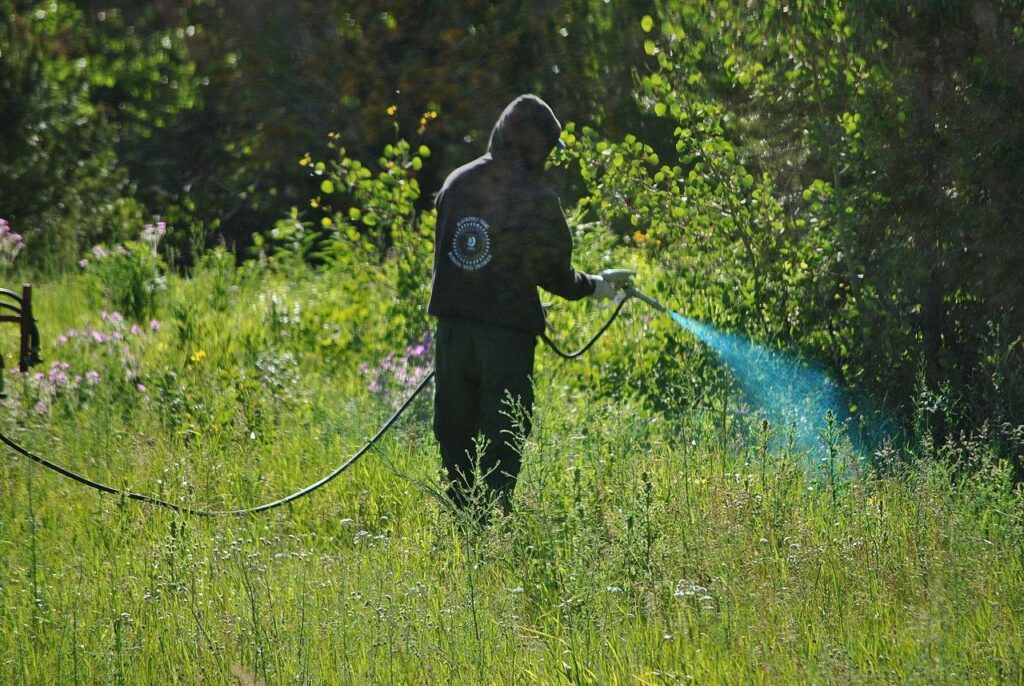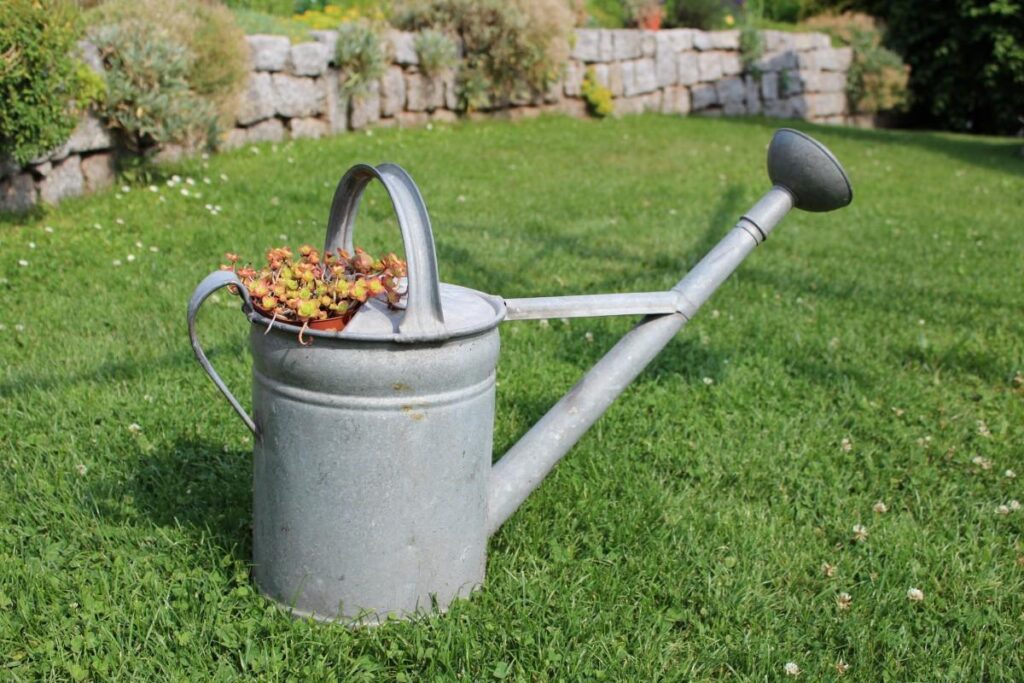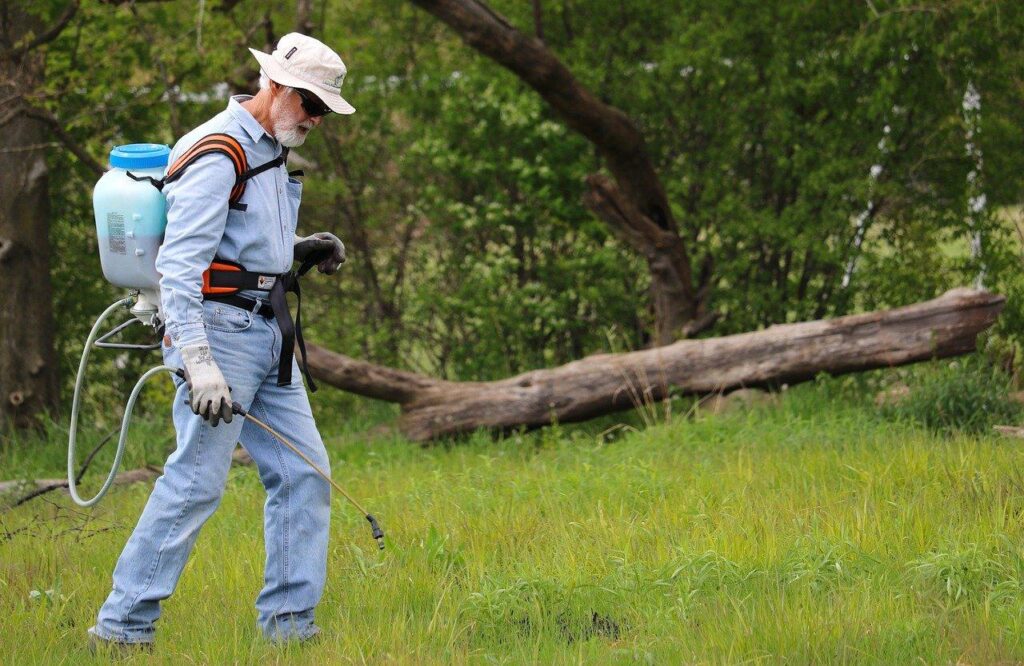Seeing weeds feels terrible after all the hard work that you have put into your lawn, doesn’t it? The best way to avoid a weed infestation is to maintain a healthy lawn. A dense turf on its own is an excellent defense against weeds. However, weeds might still pop up uninvited in your lawn from time to time. In this article, we will discuss about 2 4 d lawn weed killer.

2,4-D is a selective herbicide that is effective against most broadleaf weeds.
Finding the best weed killer for home lawns and other turf areas can be a daunting task. Nonetheless, if you are ever in the market for buying weed killers, you must have heard of 2-4 D weed killer. It is one of the best selective weed killers on the market because of its easy use and effectiveness against a broad range of grass weeds.
You can also use 2,4-D to kill all kinds of actively growing non-grassy weeds in your lawns. It works particularly well against perennial broadleaf weeds and can be used on lawns, farms, pastures, golf courses, roadsides, and other turf areas. However, you will have to be careful about the timing, mixing ratio, and application rate.
Keep reading our article to find out the answers to questions like how to use 2,4-D in lawn care correctly? Is 2,4-D safe? How to mix 2,4-D? Happy Reading!
List of Weeds That 2,4-D Kills
Here is a list of weeds that can be killed using 2,4-D weed killer:
| Alder | Galinsoga | Puncture vine |
| Alligator weed | Goatsbeard | Purslane |
| American lotus | Goldenrod | Ragweed |
| Arrowhead | Goosefoot | Red clover |
| Artichoke | Ground ivy | Rush |
| Aster | Gumweed | Russian thistle |
| Austrian field cress | Healall | Sagebrush |
| Beggartick | Hemp | Salsify |
| Biden | Henbit | Shepherd’s Purse |
| Bindweed | Hoary Cress | Sicklepod |
| Bitter wintercress | Honeysuckle | Smartweed |
| Bittercress | Horsetail | Sneezeweed |
| Bitterweed | Indiana mallow | Southern wild rose |
| Blackeyed | Indigo | Sowthistle |
| Blessed thistle | Ironweed | Spanish Needle |
| Blue lettuce | Jenny | Spatterdock |
| Box elder | Jerusalem artichoke | Speedwell |
| Broomweed | Jewelweed | St. John’s Wort |
| Buckhorn | Jimsonweed | Stinging nettle |
| Bull thistle | Knotweed | Stinkweed |
| Bull nettle | Kochia | Sumac |
| Bulrush | Lambsquarter | Sunflower |
| Bur ragweed | Locoweed | Susan |
| Burdock | Lupine | Sweet clover |
| Buttercup | Mallow | Tanweed |
| Canada thistle | Many flowered aster | Tarweed |
| Carolina geranium | Marijuana | Thistle |
| Carpetweed | Marsh elder | Toadflax |
| Catnip | Mexican weed | Tumbleweed |
| Chickweed | Morning Glory | Velvet leaf |
| Chicory | Mousetail | Vervain |
| Cinquefoil | Musk Thistle | Vetch |
| Cockle | Mustard | Virginia copperleaf |
| Cocklebur | Nettle | Virginia creeper |
| Coffee bean | Nutgrass | Water hyacinth |
| Coffeeweed | Orange hawkweed | Water lily |
| Common sowthistle | Parrot feather | Water plantain |
| Creeping | Parsnip | Water primrose |
| Croton | Pennycress | Water shield |
| Curly indigo | Pennywort | Wild carrot |
| Dandelion | Pepperweed | Wild garlic |
| Devil’s claw | Pigweed | Wild lettuce |
| Dock | Plantain | Wild onion |
| Dogbane | Poison hemlock | Wild parsnip |
| Duckweed | Poison ivy | Wild radish |
| Elderberry | Pokeweed | Wild rape |
| Flea bane (daisy) | Poorjoe | Wild strawberry |
| Flixweed | Poverty Weed | Wild sweet potato |
| Florida pusley | Prickly lettuce | Willow |
| Frenchweed | Primrose | Witchweed |
Related: Garden Weeds With Pink Flowers (And How To Get Rid Of Them?)
Is 2,4-D safe?

2,4-D and other herbicides that contain 2,4-D as an active ingredient shouldn’t be used in non-crop areas.
2,4-D is a widely used herbicide against broadleaf weeds. It can be used in any non-crop areas, including lawns, pastures, golf courses, patio areas, roadsides, fence rows, drainage ditch banks, and similar ornamental turf. However, weed killers containing 2,4-D should not be used on food crops and flowering ornamentals.
Nevertheless, 2,4-D can be used safely in lawns without any issues if guidelines printed on product labels are carefully followed. Also, while reading the instructions, carefully see if the 2,4-D weed killer at hand is specifically prohibited for use on a specific grass species.
For instance, St. Augustine grass is very sensitive to 2,4-D, and 2,4-D is usually not recommended for weed control in St. Augustine grass.
Moreover, you also have to be careful about the timing of the 2,4-D herbicide spray. For example, 2,4-D should not be used to kill weeds in dormant Bermuda grass. While 2,4-D will not kill Bermuda grass in dormancy, it can still cause significant damage to the grass.
How To Use 2,4-D Weed Killer?
Even though 2,4-D is safe to use in lawns and other turf areas, there are several things you need to keep in mind while using it in your lawn. The most important of them all is to spray 2,4-D before you start planting other plants in the lawn. It can damage fruit plants, flowering plants, vegetable plants as well as some woody plants. However, if your lawn only contains grass, it is perfectly safe to spray 2,4-D on already established grass.
Here are some steps that you can take to ensure that you use 2,4-D correctly and safely:
2, 4-D Mixing

Mixing the herbicide in the correct ratio with the water for the best results.
- Ensure you have put on all the protective gear before you open the original containers in which the weed killer comes in. On contact with bare skin, 2,4-D causes skin irritation. Also, it can cause very severe eye irritation as well. Also, make sure that you dispose of the empty containers in the trash.
- It will be best if you can obtain a ready-to-use product. Then, you will not have to go through the hassle of caring for a mixing ratio and other such details.
- Each product containing 2,4-D comes with its own mixing ratio. Read the labels to find out the exact quantities. In general, you can mix around five tablespoons of 2,4-D weed killer in almost 5 gallons of water. The resulting mixture should be sufficient for a lawn with around 400 square feet of area. You can multiply the length by the width to calculate how many square feet your lawn is.
- Mixing ratio will be different for 2,4 weed killers that come in liquid concentrate. In general, you can mix three to four fluid ounces in five gallons of water.
Related: Spiky Weeds That Can Ruin Garden Beds (And How To Get Rid Of Them?)
Spraying 2,4-D

Do not spray herbicide in your lawn on a windy day.
- Any 2,4-D containing herbicide can be used for both broad-spectrum applications as well as for spot treatment. However, still take a look at the label before spraying the herbicide. 2,4-D is a very effective herbicide for spot treating the areas with a severe weed infestation.
- While spraying herbicide, make sure that there is little or no wind. In any case, do not spray the herbicide at a higher wind speed. As already stated, 2,4-D can harm other plants such as flowers and vegetables in your lawn. In addition, blowing wind can take the herbicide to unwanted areas of your lawn.
- Keep the spraying pressure as low as possible. If you have access to a fan type nozzle, try using that.
- The timing of the spray is of particular importance. It is best to spray the lawn in early spring and when the grass is still young.
- Temperature is also an important factor. If the soil temperature exceeds 90 Fahrenheit, it is best to spray on another day. Also, extremely cold weather can impact the herbicide’s effectiveness as well.
- Do not spray 2,4-D herbicide on wet grass. It will significantly reduce herbicide effectiveness, and in some cases, you might have to reapply the herbicide. However, some ester forms of 2,4-D herbicide are somewhat waterproof.
Frequently Asked Questions (FAQs)
What weeds 2 4 d kills?
2,4-dichlorophenoxyacetic acid or 2,4-D is widely used to kill broadleaf weeds. It was the first selective herbicide on the market that was specifically able to control a number of broadleaf plants.
It kills broadleaf weeds ranging from the likes of poison ivy to simple pesky lawn weeds such as dandelions and clover. All in all, 2,4-D can control most broadleaf weeds that you might come across in your home lawns. Also, please look at the list above, which names all the weeds you can control using 2,4-D.
Can 2,4-D kill crabgrass?
2,4-D is very effective against broadleaf weeds. However, it will not kill most of the grassy weeds, crabgrass among them. As you can see in the table above, nutgrass is the only grass that can be killed by 2,4-D. So, it will not kill crabgrass.
If you are dealing with a crabgrass weed problem, try using a strong pre-emergent herbicide to maintain a weed-free lawn. However, most weed control herbicides available are usually non-selective, damaging other plants as well.
Is 2,4-D safe for humans and animals?
Overall, 2,4-D is only mildly toxic for humans. Its acid form can cause severe irritation of the eyes or skin. Extreme exposures can also cause cancer, so make sure you put on all the protective gear during herbicide-centered weed control practices.
As far as animals are concerned, it is mildly toxic to aquatic animals in its salt forms. However, it can be highly toxic to aquatic life in its ester form. Additionally, 2,4-D is not considered a hazard for bees and other beneficial insects.
You can also visit the National pesticide information center and Natural resources defense council websites to find more information on the safe use of 2,4-D.
Does 2,4-D need a surfactant?
For hi yield 2,4-D herbicide, it is usually recommended to use a non-ionic surfactant to increase its effectiveness against broadleaf weeds. In general, add one teaspoon of surfactant to one gallon of water. However, keep in mind that certain plants in your garden might be sensitive to the chemicals in surfactants.
How does 2,4-D work?
2,4-D is an auxin-type herbicide. It works by affecting the vital tissues of a plant that carry nutrients and water, and they start growing without stopping. In other words, 2,4-D gives a broadleaf plant a type of cancer that ultimately kills the broadleaf weed.
How long does it take to kill weeds using 2,4-D?
Existing data and lawn experts suggest that the active ingredients in the most widely used herbicides, including 2,4-D, take anywhere between 14 to 21 days to work. However, the plant tissues might start showing signs of damage before that.
If you use a surfactant that increases the uptake of selective herbicides, the results might show up even before 48 hours. The herbicide works by pushing the plants into unregulated growth. When plants start to grow uncontrollably, it results in their death.
Does 2,4-D kill grasses?
2,4-D is extensively used in rural and urban areas around fence rows, ornamental turf, roadsides and pastures, and drainage ditch banks to control broadleaf weeds. It is a selective herbicide that affects broadleaf plants and not grasses.
Therefore, you can use it to control broadleaf weeds in your lawn without harming most grass species. However, do not use 2,4-D to control weeds in dormant Bermuda grass or St. Augustine grass.
These grass species are sensitive to the 2,4-D weed killer, and 2,4-D use on them might result in severe damage. Also, it is suggested to only use 2,4-D weed killers in noncrop areas as it is slightly toxic and may put people at an increased risk of developing certain medical conditions.
How long does it take for 2,4-D to break down?
2,4-D comes in many chemical forms. Therefore, the half-life will vary depending on the chemical form used as an active ingredient in a selective herbicide.
For instance, ester forms of 2,4-D might have a shorter or longer half-life than its acid forms. In addition, potential health risks such as the cancer risk from exposure are also associated with 2,4-D use will also vary with its chemical form.
How many hours does it take for 2,4-D to dry?
Most ready-to-use products take around one to eight hours to dry. However, the time 2,4-D takes to dry will vary depending on its chemical formulation.
How long after spraying 2,4-D can I plant grass?
In general, you should wait for a month before planting grass after spraying your lawn with 2,4-D. You can also use 2,4-D with post-emergent herbicide or other selective herbicides after you have planted the grass; however, in this case, when you have already planted grass, wait at least after the third mowing before you use 2,4-D to control the uncontrolled growth of weeds in your lawn.
Sources For Further Reading
- 2,4-D General Fact Sheet. (2022). Retrieved 15 April 2022, from http://npic.orst.edu/factsheets/24Dgen.html#:~:text=%2D858%2D7378.-,How%20does%202%2C4%2DD%20work%3F,are%20called%20auxin%2Dtype%20herbicides.
- 2,4-D | US EPA. (2014). Retrieved 15 April 2022, from https://www.epa.gov/ingredients-used-pesticide-products/24-d
- 2,4-D. (2018). Retrieved 15 April 2022, from https://www.dhs.wisconsin.gov/chemical/24d.htm
Hope you like our 2 4 d lawn weed killer article. Please also check out our other articles:
How To Get Bermuda Grass To Spread Fast | Bermuda Grass Lawn Care Tips
Is Sand Good For Lawns? (and What Type of Sand for Lawns Is Best)
St. Augustine Grass Vs. Bermuda Grass: What’s The Difference And Which Is Better?







